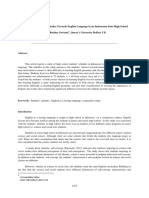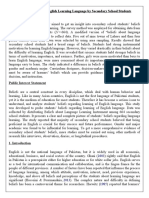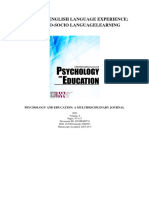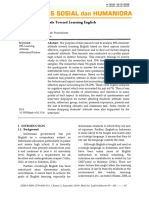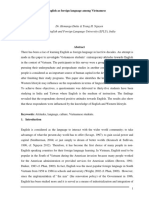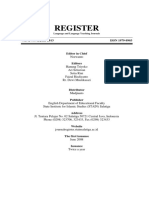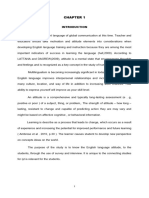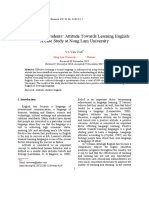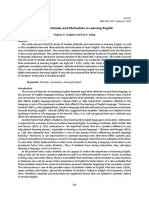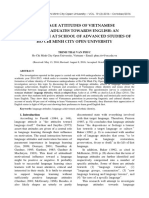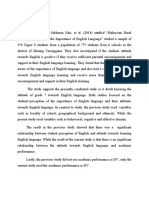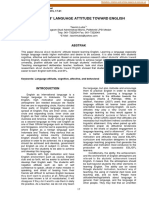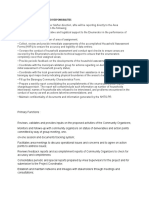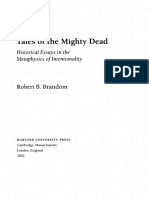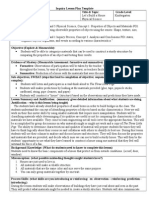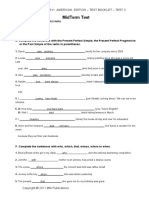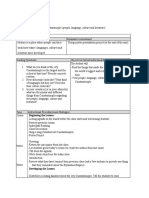Langua: Journal of Linguistics, Literature, and Language Education, Vol. 6., Num.
2
EISSN: 2623-1565
https://jurnal.stkipkieraha.ac.id/index.php/langua
The Language Attitude of Senior High School
Students towards English Language
Authors : Fia Vauliany Br Siringo-ringo1*, Ketut Artawa², Yana
Qomariana³
1, 2, 3
Affiliations : Udayana University
*Correspondence : viasiringoringo@gmail.com
Abstract : English is one of the most important languages for students to
learn since it is the most spoken language in the world and has
long become the global lingua franca. Hence, this study is
aiming to find out the attitude of students, particularly senior
high school students towards the English language. This study
applied the combination of the two methods, the quantitative
one in analyzing the data, and the qualitative method in
providing the results of the research. Meaning, the data
observed were in the form of circular diagrams, and the
provided results were in the form of word collection. The data
were obtained from a prepared questionnaire concerning
students' language attitudes toward the English language. The
subjects of the questionnaire were the students of X-5 and X-7
graders of SMA Negeri 1 Kabanjahe for the academic year of
2022 with a total number of fifty students. The result showed
that the dominant attitude reflected by the students is positive.
Keywords : language attitude, English language, senior high school
License : This work is licensed under a Creative Commons
Attribution 4.0 International License (CC-BY)
Copyrights : © 2023 by Authors
47
� Langua: Journal of Linguistics, Literature, and Language Education, Vol. 6., Num. 2
EISSN: 2623-1565
https://jurnal.stkipkieraha.ac.id/index.php/langua
1. Introduction
Language attitude can be defined as an evaluative reaction toward different language
varieties. People will always have attitudes, feelings, and beliefs regarding language in
general, the language of other people as well as their own language. People could be proud
and happy when other people hear their language and some others could be embarrassed
instead. People may be excited to learn other languages, but some others may be reluctant
and even totally have no will to do it. Some people may prefer to use other languages to their
own language. All of these situations present the existence of language attitudes. Most
simply, language attitude can be divided into two categories, positive and negative attitudes.
Studying the language attitudes of students towards the English language is interesting
because it is one of the factors that encourage their motivation and enthusiasm in learning the
language. The concern about the learners' attitudes toward the target language was
emphasized by Gardner et al (1985), who stated that the attitude of a learner in learning
another language plays a key role in motivating them to learn that language. Kara (2009)
stated that apart from opinions and beliefs, attitudes toward learning have a certain influence
on the behavior of students and consequently on their performance. It has been argued that
students possessing positive beliefs about language learning will have a tendency for
improving a more positive attitude towards language learning. There are many various
reasons why students' attitudes toward language learning are important. "Attitude is one of
the factors influencing foreign language learning since how much effort students put into
language learning depends in part on their attitudes" (Gardner, et al 1985).
Furthermore, in the study conducted by Seyyed Behrooz Hosseini (2013) entitled
"Language Learners' Attitudes and Beliefs: Brief Review of the Related Literature and
Frameworks" It was proven that attitude and perception play an important role in enabling
learners to learn effectively. It was stated that the motivation of students, the types of
assignments given, cultural background, and previous experience all contribute to the way
learners behave toward their understanding of learning strategies and their ability to sustain
higher levels of learning. The study also found out that students need to have a clear
understanding of the language taught and student beliefs, because learners with realistic and
informed beliefs are more likely to behave be productive in class, work harder outside of
class, and (most importantly) last longer with language learning. The study concluded that
having a positive or negative attitude toward certain languages and the way students perceive
that language can have a considerable influence on their performance in the language itself.
English has been appointed to be the international language or the global lingua franca for
a very long time. It was contended by Crystal (2000) and Nunan (2001), as well as British
Council (2013), that the spread of English has been providing immeasurable access to the
modern world of science, information, and communications technology (ICT), money,
power, international communication, intercultural understanding, entertainment, and many
other fields.
The widespread usage of English made it being taught in over 118 countries, including
Indonesia. English is commonly started being taught to students from the third grade of
primary school but several schools required students to learn English from the first grade of
primary school or even from elementary school.
48
� Langua: Journal of Linguistics, Literature, and Language Education, Vol. 6., Num. 2
EISSN: 2623-1565
https://jurnal.stkipkieraha.ac.id/index.php/langua
English presently becomes more and more important for students, especially the ones who
have been at senior high school level, for their future since almost every occupation started to
consider that English ability is a significant qualification. It is hardly ever to find a job
vacancy that does not require a postulant to have the ability to use English. For students who
want to continue their education at university, English will be one of the subjects they study
no matter what major they take. Thus, both for finding a job and studying in university,
English ability includes one of the important aspects for the qualification.
Not only learning English is important, but it is also good for our brains. In an article
written by Roitman (2013), it is stated: “Because the language centers in the brain are so
flexible, learning a second language can develop new areas of your mind and strengthen your
brain's natural ability to focus, entertain multiple possibilities, and process information,”.
Senior High School students are expected to have better English language proficiency
since they are the generation who will soon live college and working life. However, it was
observed that most students find it hard to keep up with the lessons taught in class and in the
end even consider English as a less important or even unimportant thing to learn. The
researcher associated this problem with students' attitudes toward English itself. This study
looked at the concept of attitude as one of the main affective factors to be able to learn
English effectively. More specifically, it investigated the attitudes of high school students
towards English, especially in the classroom, taking into account several assessment
variables.
2. Method
The data of this analysis were obtained from a prepared questionnaire regarding language
attitudes toward the English language that took senior high school students of X-5 and X-7
graders of SMA Negeri 1 Kabanjahe for the academic year of 2022 as the subjects. The data
was collected by asking the subjects to fill out the questionnaire prepared by the researcher.
Afterward, the result of the questionnaire was read and analyzed with the final intention of
finding a conclusion.
The method used in conducting this research was the descriptive quantitative method. This
method is also known as survey research (Gay et al 2012: 183) in which the data were
collected numerically with the purpose to answer questions about the right status of the
subject of a study. This research method involves collecting data to examine hypotheses or to
answer questions about people's points of view regarding a topic or an issue. Furthermore,
Creswell (2012: 376) argued that in applying this method, a researcher surveys samples to
describe their attitudes, opinions, behaviors, or characteristics of them. Thus, the data in this
study were analyzed and presented statistically by using tables and numbers that were
elaborated descriptively. The questionnaire was provided in the form of word collection and
the results were in the form of circular diagrams.
The data were analyzed by using some sort of theories of sociolinguistics proposed by
several experts, such as Crystal (1992), Petty and Cacioppo (1982), Lambert (1967), and
David Olorunsogo (2017). In presenting the result of the analysis, a combination of the
formal and informal methods was used, in which the numerical data were explicated by using
a collection of words.
49
� Langua: Journal of Linguistics, Literature, and Language Education, Vol. 6., Num. 2
EISSN: 2623-1565
https://jurnal.stkipkieraha.ac.id/index.php/langua
3. Result and Discussion
The analysis in this study was conducted by using the theories of sociolinguistics provided
below.
3.1 Language Attitude
Aristotle defined language as a speech sound produced by human beings to express their
ideas, emotions, thoughts, desires, and feelings. Language is one of the most important things
in any society because it is the means people use to share ideas, thoughts, and feelings.
Melander (2003) referred language to as a social act that can give people information about
the person they are listening to. Each human being has his/ her own attitude towards any
language including their mother tongue, their national language, their second language, and
any language they acquire and learn.
According to the Oxford Dictionary, attitude refers to a settled way of thinking or feeling
about someone or something, typically one that is reflected in a person's behavior. Thus, it
can be inferred that language attitude is the feeling someone reflects about language that is
indicated by his/ her behavior. According to Crystal (1992), language attitude is the feeling
people have about their own language or the language of others. In Baker 1988: 112-115, it is
stated that attitude is a complex construction and it can be positive and negative.
Furthermore, Petty and Cacioppo (1981) argued that the term attitude should refer to a
general positive or negative feeling about something. Thus, it can be said that language
attitude can be classified into two categories namely positive attitude and negative attitude. It
would be considered a positive attitude when someone is enthusiastic about using the
language, proud of it, and trying to keep it. On the other hand, someone will be considered to
have a negative attitude towards a language when she/ he seems to be reluctant to use the
language or embarrassed about it and even tries to stop using it.
According to Lambert (1967), attitudes consist of three components. These are the
cognitive, affective, and conative components (Dittmar 1976: 181). The cognitive component
refers to an individual's belief structure involving conscious intellectual activity such as
thinking, reasoning, or remembering, the affective component refers to something that evokes
feelings, or emotional actions or actions driven by feelings, while the conative component
comprehends the tendency to behave in a certain way towards the attitude, can also be
referred to as the way the attitude we have influences on how we act or behave. (Gardner et
al, 1985).
David Olorunsogo (2017) explicated some factors affecting someone's attitude towards a
language in his article, those are historical factors, sociocultural factors, prestige and power
of the language, political factors, economic factors, religion, ethnicity, language policy,
occupation, social class, and language policy among others.
3.2 Result and Discussion
The results of the language attitude questionnaire whose subjects are the students of X-5 and
X-7 graders of SMA Negeri 1 Kabanjahe for the academic year of 2022 with a total number
of fifty students showed that the subjects reflect different attitudes towards the English
language. The results of the questionnaire are attached below.
50
� Langua: Journal of Linguistics, Literature, and Language Education, Vol. 6., Num. 2
EISSN: 2623-1565
https://jurnal.stkipkieraha.ac.id/index.php/langua
Table 1. Language attitude questionnaire results concerning the cognitive components
Percentage (%)
Statements/ Questions
Agree Strongly Disagree Strongly
Agree Disagree
1. You are excited about learning 60% 24% 14% 2%
English because it makes your
parents or your teacher proud.
2. You are excited about learning 62% 18% 20% -%
English because you want to get a
good mark at school.
3. English is important for you 48% 52% -% -%
because you want to
communicate with foreigners.
4. English is important for you 48% 44% 6% 2%
because you want to make
friends with foreigners.
5. English is important for you 36% 30% 34% -%
because you want to study
abroad.
6. English is important for you 36% 64% -% -%
because you may need it later for
your job
7. English is important for you 58% 30% 8% 4%
because all educated people must
be able to use English.
8. You learn English because you 50% 28% 22% -%
have to.
9. You think you are able to use 50% 4% 44% 2%
English well.
10. You like to assess other people's 46% 8% 40% 6%
English skills.
11. You believe that with intensive 48% 44% 8% -%
practice, you can master the
51
� Langua: Journal of Linguistics, Literature, and Language Education, Vol. 6., Num. 2
EISSN: 2623-1565
https://jurnal.stkipkieraha.ac.id/index.php/langua
English language.
12. English is an important language 46% 50% 4% -%
for you to know.
Table 1 above shows the result of the assessment of the student's attitude toward English
in accordance with the cognitive component. The assessment was concerned with the
student's intellectual activities such as their enthusiasm for joining English classes at school,
their ability to understand the materials of English subjects, the tendency for them to assess
other people's English abilities, and so on. From the table above, we can also see the reason
why the students like English and consider it important to them.
The students have given different opinions for each of the statements. However, it can be
seen that most of the statements were agreed by the students and that means most of them
reflect positive attitudes towards the English language. From the last statement, it can be
concluded that 96% of the students, meaning forty-eight out of fifty students, believe that
English is important for them.
Moreover, from the first to the eighth statements, it was found that the mean for students
who agree is 86%. This finding indicates that forty-three of fifty students obviously know
why English is important to them. However, statement number nine shows that 46% or
twenty-three students do not think that they are good at English. This means that there are
approximately twenty students who are not good at English but have positive attitudes to it.
This proves that a person's inability to use a language does not indicate that they have a
negative attitude toward the language.
Table 2. Language attitude questionnaire results concerning the affective components
Percentage (%)
Statements/ Questions
Agree Strongly Disagree Strongly
Agree Disagree
1. You enjoy studying English. 72% 16% 10% 2%
2. Learning English is fun. 66% 22% 10% 2%
3. English is one of your favorite 52% 18% 26% 4%
subjects.
4. Compared to other foreign 56% 22% 18% 4%
languages, you prefer English.
5. You like English as much as you 56% 22% 20% 2%
like your mother tongue.
52
� Langua: Journal of Linguistics, Literature, and Language Education, Vol. 6., Num. 2
EISSN: 2623-1565
https://jurnal.stkipkieraha.ac.id/index.php/langua
6. You are not afraid of making 44% 8% 40% 8%
mistakes in using English.
7. You are not afraid of being 42% 8% 46% 4%
laughed at for making mistakes
in using English.
8. It is often for you to be anxious in 38% 14% 44% 4%
joining an English class.
9. You are comfortable and 56% 14% 24% 6%
confident in joining the English
class.
10. You know why English is 50% 50% -% -%
important to you.
Table 2 represents the result of the assessment of the student's attitude toward English
concerning the affective component. The assessment was regarding the students' personal
feelings about English particularly when joining English class. According to the results, the
students reflect mostly positive feelings which means that most of them are having positive
attitudes towards English. From the statements one to five, we can conclude that 80% of the
students are interested in English because they think it is fun, enjoyable, and better than any
other foreign language, some of them even like it as much as they like their mother tongue
and it is one of their favorite subjects. This result means that forty out of fifty students like
English and are enthusiastic to learn it.
Statements six to nine are concerned with the student's confidence in using English. Based
on the result, there are 55% of twenty-seven students stated that they have good self-
confidence in using English and that they are not even afraid of making mistakes and being
laughed at, but 45% of twenty-two students are not confident to use English. Although the
students who dominate are students with high self-confidence, not a few students have low
self-confidence in using the English language.
The last statement represents the students' consciousness of the importance of English for
them, and the result shows 100% of students, meaning all of them realize and know the
reason why it is important. From these findings, it can be inferred that almost all students
reflect positive attitudes toward English.
53
� Langua: Journal of Linguistics, Literature, and Language Education, Vol. 6., Num. 2
EISSN: 2623-1565
https://jurnal.stkipkieraha.ac.id/index.php/langua
Table 3. Language attitude questionnaire concerning the conative components
Percentage (%)
Statements/ Questions
Agree Strongly Disagree Strongly
Agree Disagree
1. Being able to understand the 50% 48% 2% -%
materials of English subjects
often makes you happy.
2. You feel happy interacting with 54% 16% 26% 4%
your teacher in English class.
3. You feel proud if you are able to 46% 46% 8% -%
use English well.
4. You interact actively with your 50% 8% 32% 10%
teacher in English class.
5. You use English sometimes in 56% 14% 26% 4%
your daily life.
Table 3 shows the result of the assessment of the student's attitude towards English
according to the conative component. The assessment was in accordance with the student's
personal actions and feelings that are influenced by their respective attitude towards English.
The first to the third statements are concerning their feelings when they are using or learning
English. From the results, it can be concluded that 72% of students feel happy and proud
when they are good at English, for instance being able to understand the material explained in
class, interacting with their English teacher, and being able to use English well. This implies
that thirty-six out of fifty students have positive attitudes towards the English language.
The last two statements in the table above are regarding the actions done by the students
because of the attitude they have. From the results, we can infer that the students dominantly
reflect positive attitudes towards the English language because 64% or thirty-two of them
actively interact with their teacher in English class and use English sometimes in daily life.
4. Conclusion
From the results and findings provided above, it can be concluded that the dominant attitude
towards English, reflected by the students of X-5 and X-7 graders of SMA Negeri 1
Kabanjahe for the academic year of 2022 is positive. This indicated that as senior high school
students, most of them have realized and understood the importance of the English language
to their future. However, not a few students still have low self-confidence in using English,
also some students thought that they are not good at English. Fortunately, all of the students
know that English is important for them, so they won't lose interest to learn it to make their
English better.
54
� Langua: Journal of Linguistics, Literature, and Language Education, Vol. 6., Num. 2
EISSN: 2623-1565
https://jurnal.stkipkieraha.ac.id/index.php/langua
References
Baker, M. C. (1988). Incorporation: A Theory of Grammatical Function Changing. Chicago,
IL: University of Chicago Press.
Cacioppo, J. T., & Petty, R. E. (1982). The Need for Cognition. Journal of Personality and
Social Psychology, 42 (1), 116–131. https://doi.org/10.1037/0022-3514.42.1.116
Canceran, Jane B, Conchita M Temporal. (2020). Attitude of Grade 12 SHS Academic Tracks
Students Towards Speaking in English. Sto. Tomas National School, Cagayan State
University. Philippines.
Council, British. (2013). The English Effect. British Council.
https://www.britishcouncil.org/sites/default/files/english-effect-report-v2.pdf
Creswell, J. W. (2012). Educational Research Planning, Conducting, and Evaluating
Quantitative and Qualitative Research (4th Ed.). Boston, MA Pearson.
Crystal, David. (2000). Language death. Cambridge: Cambridge University Press.
Dittmar, Norbert. (1976). Sociolinguistics A Critical Survey of Theory and Application.
German: Edward Arnold Ltd. Haron, Isahak. 1996.
Gardener, R.C., Lalonde, R.N., Moorcroft, R. (1985). The Role of Attitudes and Motivation in
Second Language Learning: Correlational and Experimental Considerations. 35, no.
2, 207-227. https://doi.org/10.1111/j.1467-1770.1985.tb01025.x
Gardner, R. & Lambert, W. (1972). Attitudes and Motivation in Second Language Learning.
Rowley, MA: Newbury House.
Garrett, Peter. (2010). Attitude to Language. New York. Cambridge University Press.
Gay, L., Mills, G. and Airasian, P. (2012) Educational Research Competencies for Analysis
and Applications. 10th Edition, Pearson, Toronto.
Hohenthal, Annika. Measurement Techniques-What is a Language Attitude? Postcolonial
Web.
Hosseini, Seyyed Behrooz. (2013). Language Learners’ Attitude and Beliefs: Brief Review of
the Related Literature and Frameworks. International Journal on New Trends in
Education and Their Implications 04, no. 4, 63-64.
http://ijonte.org/FileUpload/ks63207/File/06a.hosseini.pdf
Jaime, Mariana. LANGUAGE ATTITUDES. Academia.
Kara, A. (2009) The Effect of a ‘Learning Theories’ Unit on Students’ Attitudes towards
Learning. Australian Journal of Teacher Education, 34, 100-113.
https://doi.org/10.14221/ajte.2009v34n3.5
Lambert, W. (1967). A Social Psychology of Bilingualism. Journal of Social Issues, 23, 91-
109. doi10.1111/j.1540-4560.1967.tb00578.x.
Nunan, D. (2001). Second Language Teaching and Learning. Beijing: Foreign Language
Teaching and Research Press.
55
� Langua: Journal of Linguistics, Literature, and Language Education, Vol. 6., Num. 2
EISSN: 2623-1565
https://jurnal.stkipkieraha.ac.id/index.php/langua
Olorunsogo, David. (2012). Factors Affecting Language Attitudes. Crystal Curation.
Paola-Raos, Riana. (2013). Language Attitude in the Second Language Situation. Per
Linguam, 6 NO. 2 1990.
Peeters, B. (2019). The Year’s Work in Modern Language Studies, 79, 23–54.
https://www.jstor.org/stable/26748171
Putra, Erlangga. (2020). The Importance of Learning English Nowadays.
Robins, Robert Henry. (2021). language. Encyclopedia Britannica.
Roitman, D. (2013, June 13). Why It Makes More Sense Than You Know to Learn a Second
Language. Huffington Post. Retrieved from http://www.huffingtonpost.com/dan-
roitman/whyit-makes-more-sense-t_b_3435076.html
Tambunan, Eva Rosmalasari et al. The Attitude Towards Speaking English. Tanjungpura
University. Pontianak.
56












